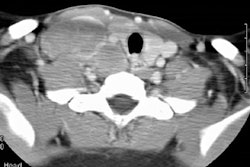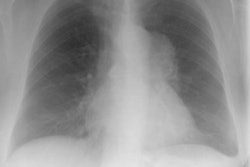HIV-associated human herpesvirus 8-positive primary lymphomatous effusions: radiologic findings in six patients.
Morassut S, Vaccher E, Balestreri L, Gloghini A, Gaidano G, Volpe R, Tirelli U, Carbone A
PURPOSE: To define the imaging features of body cavity-based lymphoma (BCBL) related to the acquired immunodeficiency syndrome. This is a peculiar type of non-Hodgkin lymphoma harboring infection by human herpesvirus 8 (HHV-8) and displaying a peculiar tropism for the serous body cavities. MATERIALS AND METHODS: At diagnosis of BCBL, six consecutive patients were investigated with radiography of the chest and conventional computed tomography (CT) of the chest and abdomen. For all patients, clinical features and results of biologic characterization of the lymphoma were also available. RESULTS: In all patients, chest radiographs displayed bilateral or unilateral pleural effusion in the absence of parenchymal opacities or mediastinal enlargement. CT scans confirmed chest radiographic findings and revealed a slight thickening of the parietal pleura in all patients and a pericardial thickening in four patients. CT also depicted pericardial and abdominal effusions in five and two patients, respectively, in the absence of solid tumor masses or parenchymal abnormalities. CONCLUSION: BCBL must be included among the differential diagnoses of serous effusions detected radiologically in individuals infected with the human immunodeficiency virus (HIV). Since the combination of serous effusion, slight serosal thickening, and absence of solid masses is compatible with, though not specific for, BCBL in the context of HIV infection, radiologic findings need to be complemented by a detailed biologic and virologic characterization of tumor cells.




